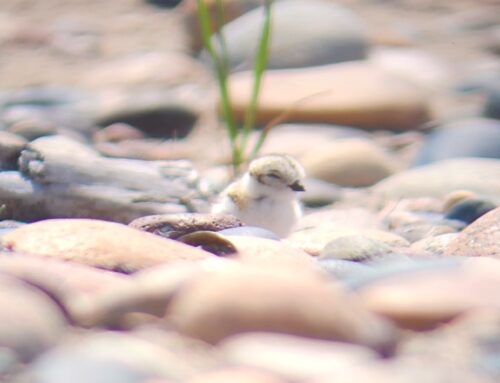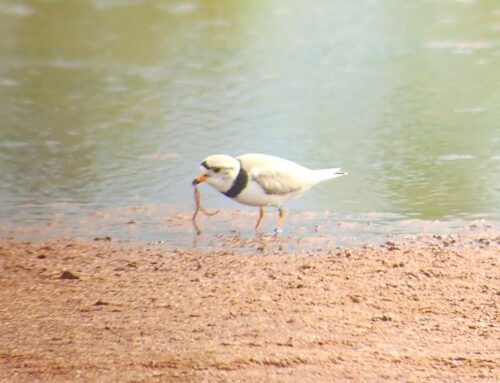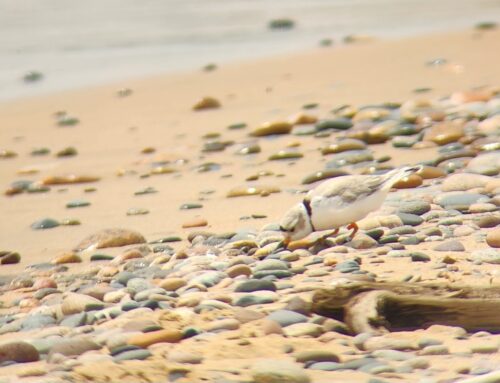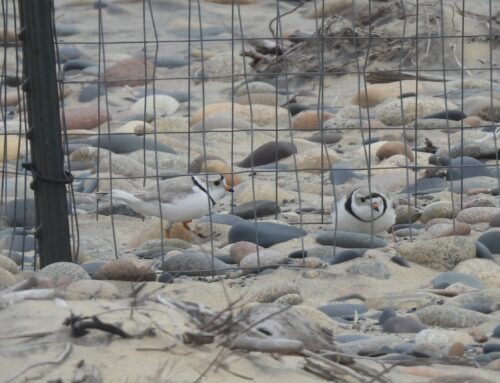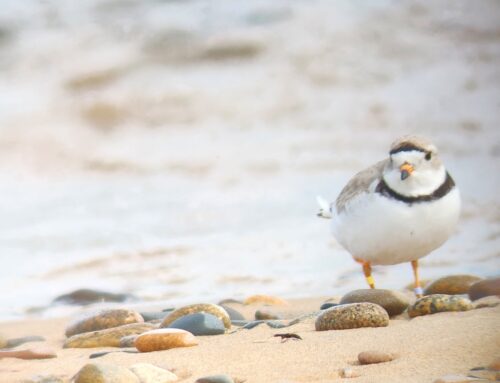
A section of the shoreline will be closed through Aug. 5. People can still access the tip of the Point from the bayside shoreline.
Before I talk about the recent Piping Plover activity, I want to give a quick update on the beach closures at Whitefish Point. The U.S. Fish and Wildlife Service has authorized the lakeside shoreline parallel to the closed area boundary to be closed to all public access until August 5. This closure protects the large number of Piping Plover chicks utilizing the shoreline for feeding. Thank you for understanding this closure and helping give the plovers one more level of safety.
As for the plovers, three out of four nests have hatched, with a total of 10 chicks hatching. Nest 1 had two hatch, nest 2 had four hatch, and nest 3 had four hatch. The chicks continue to grow, and for the first time this afternoon, I observed several chicks starting to try out their wings! They still have some time before they are able to fly, but it just goes to show how quickly things move with their development.
One thing I have to do as part of my duties is to get a daily count of the chicks. This is important because it allows us to know how many chicks fledge. Some days I can count the 10 chicks in under an hour, while others have taken me over five hours to get a full count. If the plovers are hanging out in the dune grass, then it’s usually a guarantee that I will need to be patient for some time to get a full count. Meanwhile, if they’re on the shoreline, then it’s pretty straightforward. Whenever I get on the beach in the morning, I’m always a little anxious until I find all of the chicks. So you can imagine my frustration yesterday when I could only find two chicks from pair 2 when there should be four. I looked multiple times and spent several hours watching their territory, only to count two chicks. Where were they? Were they predated? Or were they just separated from the rest and hidden? My hope was that they reappeared today, July 14. When I got to pair 2’s territory today, my heart sank when I again counted two chicks. There’s been plenty of predator activity the last several days, so I assumed that something must have gotten them when I wasn’t out there.
You can imagine my surprise when I moved on to count pair 1’s chicks and counted 3! Pair 1 only laid two eggs! One of the chicks from pair 2 had moved over and is hanging out with pair 1! I couldn’t believe it. I was glad to know that at least one of the missing chicks was still alive. I figured I better watch that brood a little longer and was rewarded to see the fourth chick with pair 1! The mystery of what happened to the missing chicks has been solved.
As far as other shorebirds go, there have been a lot of fun sightings in the last week or so. Good numbers of yellowlegs have been seen daily, and the first Baird’s and Pectoral Sandpipers of “fall” migration have also been observed. On the morning of July 12, a dowitcher was in the pond with a nice flock of Lesser Yellowlegs. Solitary Sandpipers have been seen on several days, and a flock of four Wood Ducks was a nice treat too.

Indigo. Photo by Alec Olivier

Pectoral and Least Sandpipers. Photo by Alec Olivier

Wisky. Photo by Alec Olivier
~ Alec Olivier
2022 Piping Plover Monitor
Featured image: Pair 2 Piping Plover chick. Photo by Alec Olivier
You can keep up with the Piping Plovers at the Point by reading Alec’s blogs or following WPBO on social media (Facebook, Instagram, and Twitter).
You can also check out the video from 2021 featuring the Piping Plovers at the Point.


